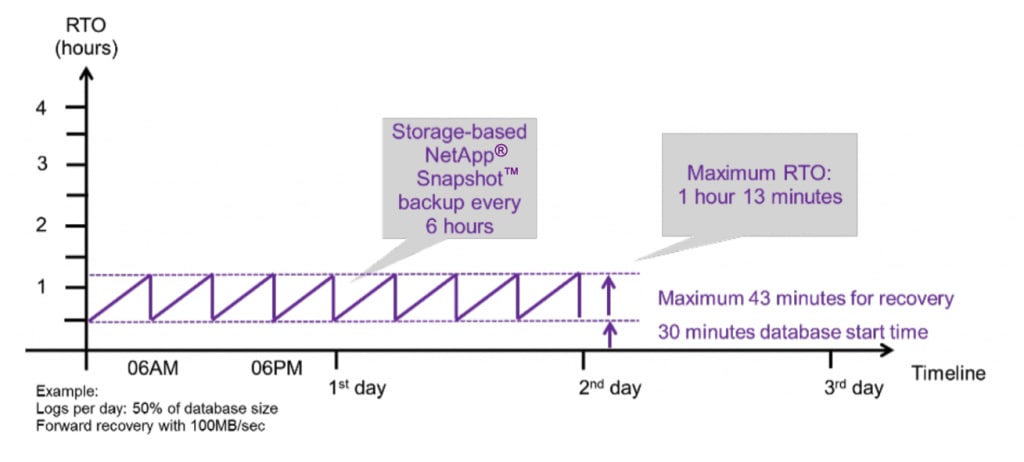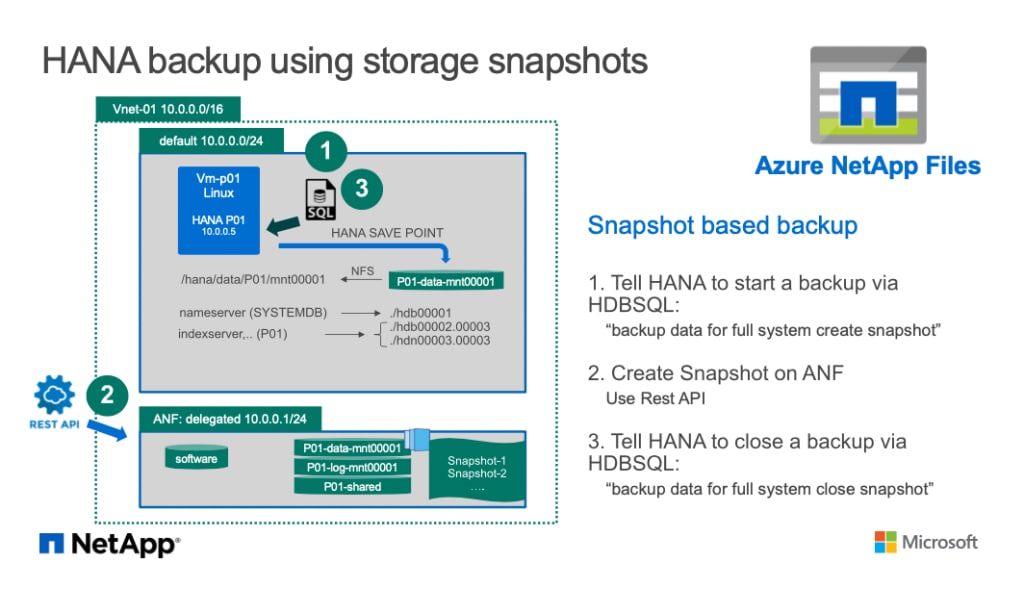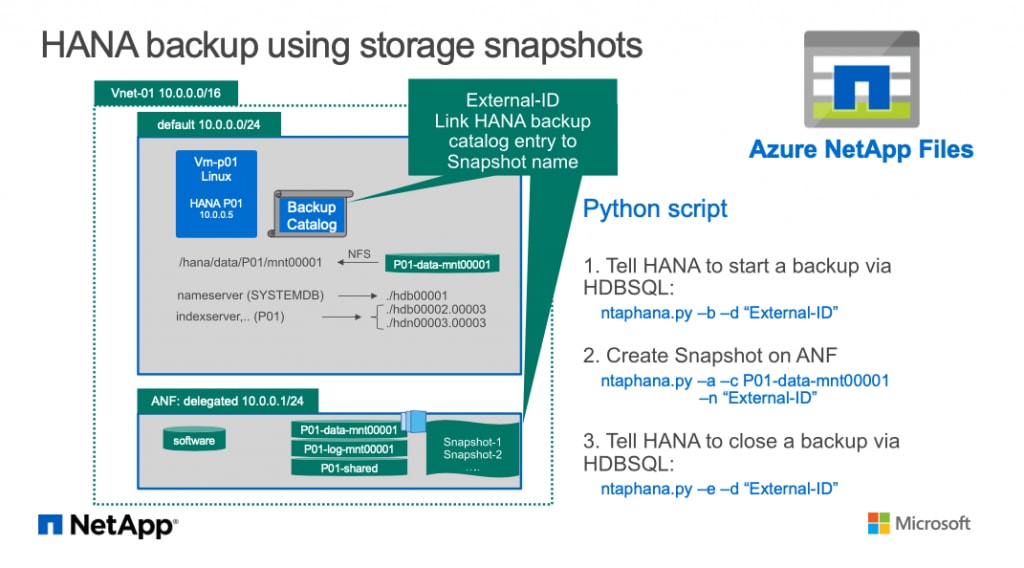Azure NetApp Files - SAP HANA Backup in Seconds


Bernd Herth
Azure NetApp® Files was announced as generally available at the end of May 2019. Azure NetApp Files adds a new and powerful enterprise-grade NFS and SMB file service to the Microsoft Azure Intelligent Cloud platform, dramatically simplifying and improving SAP deployments in Azure. Now customers can provision all kinds of SAP shared file systems, as described in my previous blog post, Azure NetApp Files: The Best Fit for Your SAP Shared Files. But there are many more use cases and features that have the potential to revolutionize SAP cloud deployments in Azure.
NetApp customers may already know where I’m going – it’s all about the additional value of ONTAP® to manage SAP systems. As a global SAP technology partner, NetApp has a long history of excellent solutions and products with deep integration into SAP applications, enabling customers to use NetApp ONTAP SnapshotTM technology for fast, storage-efficient, and reliable backup and recovery. The results are improved SLAs and lower cost, as well as fast and storage-efficient cloning for faster time to market while improving quality and further lowering cost.
Azure NetApp Files adds this same foundation to Azure, enabling these features to be used in the cloud as well. In this blog post I describe how to use Azure NetApp Files storage Snapshot based backups for your dev/test SAP HANA deployments.
The challenges of extending SAP HANA backups into the cloud
The typical challenge with large-sized database environments like SAP HANA is the rapid creation and restoration of backup data. Most HANA implementations are immensely mission critical and don’t allow for low SLAs with very high RPO and RTO characteristics. Typical legacy approaches to backup using data dump to disk or tape lead to unacceptable RPO and RTO figures that are measured in hours, and sometimes even days. As enterprise customers move their mission-critical SAP HANA estates into Azure, more enterprise-grade solutions are required. This is where application-consistent Snapshot copies come into play.
Solving the challenges with SAP HANA backups using Snapshot copies
Here are the key benefits of storage-based Snapshot copies:
- Snapshot copies can be created – and kept on the system! – with no performance impact on the storage system.
- Because these copies are created on the storage system, they don’t consume database resources.
- Recovery from a data Snapshot copy is much faster than recovery from a data backup, resulting in aggressively short RTOs (down to minutes).
- Snapshot copies are near-instantaneous, allowing frequent creation, which means even shorter RTO, because only a few log backups need to be applied.
The following examples illustrate these benefits.
Traditional backup

To create a backup, a full database export has to be generated. Given the large amount of data (and typically limited bandwidth) the creation of backups typically takes hours. As a result, it is possible to complete only one or two backups per day. On top of that, restores usually take longer than the backup itself.
Snapshot copy-based backup

With Snapshot copy-based backups, many more backups can be created during the day. Creating a Snapshot copy takes only seconds, because no data needs to be copied on the storage system. Recovery from an ONTAP Snapshot copy is near-instantaneous (independent of data size) and can be done from a fairly recent copy. Therefore recovery time is far shorter because many fewer redo logs need to be applied after the copy has been restored.
Azure NetApp Files fully supports the fast and reliable ONTAP Snapshot capabilities, using either the standard GUI functionality of the Azure Portal or a programmatical API approach. Either way, an application-consistent Snapshot backup can be completed in seconds, regardless of the size of the file system, with no impact on the storage performance, similar to an on-premises situation. In the past, many SAP HANA customers were looking for fast and reliable snapshot-based data protection in the cloud. With Azure NetApp Files, this protection is now available.
SAP HANA backup using storage Snapshot copies
SAP HANA 2.0 SPS1 and later support creating Snapshot based backups for systems with a single tenant, and starting with SAP HANA 2.0 SPS4 also for databases with more than one tenant. Also, customers who are still using HANA 1.0 SPS12, the single-container version, can use Snapshot based backups.
Creating storage-based Snapshot backups is a simple three-step procedure, as shown in the following figure, using SAP’s SQL API. Using SAP HANA Studio and Azure Portal, the same result can be achieved by using a manual GUI-driven process.

- To ensure that the data on the persistence layer (the SAP HANA data volume) is consistent, SAP provides a SQL command to create an internal save point that is written to the data volume.
- At that point, the storage Snapshot copy of the data volume needs to be created. With Azure NetApp Files, this is done via API or GUI, and no additional file system freeze is required, as it is for other storage systems.
- After a few seconds, when the Snapshot copy has been created, the SAP HANA database backup has to be closed to allow SAP HANA to continue normal operation. With this command, a backup entry is added to the SAP HANA backup catalog.
Using Azure NetApp Files API calls to automate the backup
In a short video that we created jointly with colleagues at Microsoft, we used a small sample script based on the Python SDK for Azure NetApp Files. The script implements the necessary SQL commands for SAP HANA, as well as the commands to create the storage Snapshot copy.

The script implements the three-step procedure shown in the figure by using command line (CLI) parameters. As an example, to map the backup entry in the SAP HANA backup catalog to the corresponding Snapshot copy on the Azure NetApp Files volume, the CLI parameter External-ID is used. With this parameter, the Snapshot backup can be easily identified from the SAP HANA backup catalog for later restore operations.
The video Snapshot Based Backup for SAP HANA with Azure NetApp Files describes the complete workflow.
https://www.youtube.com/watch?v=VfqpUSf4JzU&feature=youtu.be
With Azure NetApp Files, customers can optimize the backup strategy for their SAP HANA systems in the cloud. In upcoming posts, we will discuss how to use these backups for restore and recovery and how to create additional SAP HANA system clones. For more information, see the following technical reports and web pages:
- Solution architectures using Azure NetApp Files
- NetApp Cloud Central
- SAP on Azure Landing Page
- ONTAP WAFL Snapshots
Please join us at SAP TechEd 2019 in Las Vegas next month.
Bernd Herth
Bernd Herth architects and defines NetApp's SAP solutions as TME at the SAP Partner Port at SAP headquarters in Walldorf. He has over 25 years of experience in SAP software and in planning and architecting infrastructure solutions for SAP and has held various positions in the SAP ecosystem. Herth has published articles and books focused on SAP technology and virtualization. He holds a masters degree in physics and taught computer science classes as assistant professor.